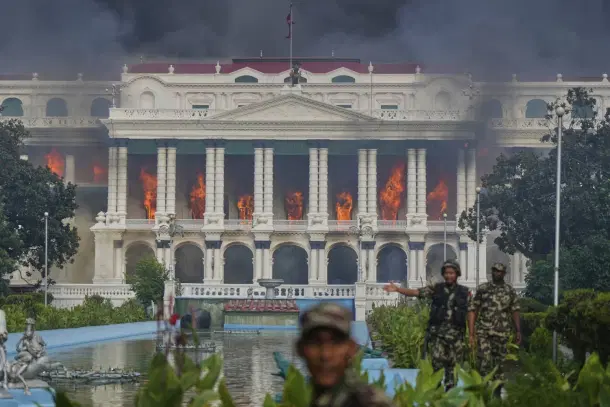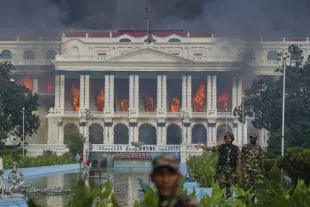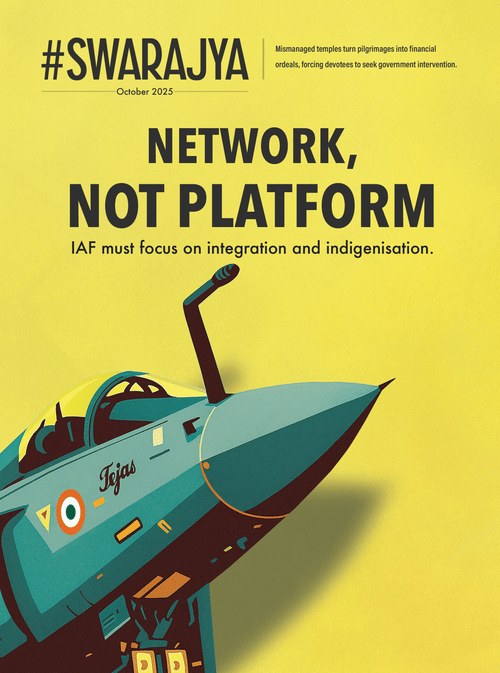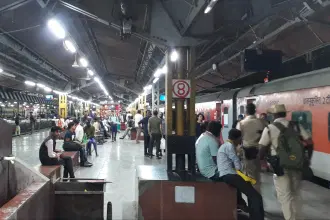World
Regime Change Or Democratic Correction: Why Labelling Nepal's Gen Z Protests As Colour Revolution May Be Just Lazy Analysis
Nabaarun Barooah
Sep 16, 2025, 01:06 PM | Updated 11:45 PM IST
Save & read from anywhere!
Bookmark stories for easy access on any device or the Swarajya app.


Nepal is no stranger to political upheaval. In less than two decades of republican democracy, the country has seen a dozen governments collapse, coalition alliances forged and broken overnight, and a citizenry growing weary of leaders who seem incapable of thinking beyond factional advantage.
The latest crisis was triggered in early September when Prime Minister K. P. Sharma Oli announced a blanket ban on 26 social media platforms, from TikTok to Instagram, in the name of "public order" following widespread discontent from the young Nepalese over government corruption. Instead of pacifying dissent, the move ignited one of the largest youth-led uprisings in Nepal's recent memory.
For days, Kathmandu and other cities swelled with protestors (mostly students, gig workers, young IT professionals) waving placards, filming chants on VPN workarounds and mocking the ban itself with viral memes. The demonstrations soon gathered momentum, and in the face of mounting street anger, Oli tendered his resignation.
As is often the case in the Indian subcontinent, explanations for the regime change quickly divided opinion. Commentators called it a "deep state-sponsored colour revolution," orchestrated from outside to destabilise Nepal. The phrase resonates with familiar tropes: the West's alleged hand in the Arab Spring, or Beijing's paranoia about Hong Kong's democracy movement.
Yet, to reduce Nepal's upheaval to a foreign plot is to miss the deeper story. What unfolded in Kathmandu was less a conspiracy and more a democratic correction, a generational rebuke against entrenched corruption and tone-deaf governance.
What Sparked the Movement?
The roots of the revolt lie in Nepal's chronic governance deficit. Corruption and nepotism have hollowed out the republic's credibility. Ministries and state-owned corporations are stacked with relatives of politicians, contracts are awarded to party cronies, and anti-graft investigations rarely touch the top tier of power.
For the average Nepali youth, politics is a privilege reserved for a few dynastic families.
Economic stagnation only compounds this anger. Youth unemployment hovers around 20 per cent. Migration has become the default escape with nearly 1,700 Nepalis leaving every day to seek work in the Gulf, Malaysia, or India.
"We live in a hell while their kids party abroad," one young influencer declared on TikTok before the ban, summing up the mood of a generation that sees its own sacrifices ridiculed by the lifestyles of the elite.
The institutional failures run deeper. Democracy in Nepal was won with blood and idealism, but in practice, it has become synonymous with horse-trading, corruption, and endless instability. Coalition governments collapse before they can deliver on any promise, whilst public services languish. For Gen Z, born after the monarchy and reared in the rhetoric of republican equality, the contrast between promise and practice is especially jarring.
Social media became the arena where this resentment was first distilled into a movement. Instagram reels and TikTok videos lampooning "Nepo Babies" and "Nepo Kids," the sons and daughters of politicians flaunting wealth abroad, went viral. Hashtags mocking the elite's hypocrisy gained millions of views, turning cynicism into collective anger.
The state's response was both heavy-handed and politically suicidal. Instead of engaging with the criticism, the Oli government banned 26 social media platforms outright. The very tool through which young Nepalis were venting their frustration was suddenly declared illegal. Far from silencing dissent, this ban acted as the spark that lit the fuse.
Within hours, encrypted groups and VPN workarounds spread protest calls. By the week's end, thousands had poured into Kathmandu's streets, transforming scattered discontent into a nationwide rebellion.
Voices from Gen Z
If one had to capture the face of Nepal's current political upheaval, it would not be the grey-haired party bosses or coalition negotiators huddled in hotels. It would be the thousands of young faces from different walks of life who poured into Kathmandu's streets with placards, VPN-enabled phones, and a conviction that they have nothing to lose.
What marks this moment apart from Nepal's long history of regime changes is its generational texture.
The monarchy fell in 2008, but most of today's protestors were children then, or not even born. They are not driven by the ideological baggage of the Maoist insurgency, nor are they loyal to the legacies of old parties. They are the first truly republican generation, born during democracy, raised online and unafraid to speak bluntly against authority.
A 20-year-old engineering student at Pulchowk campus, standing on a plastic stool to lead chants, summed up the generational mood: "We don't need leaders who ban apps. We need leaders who build futures."
His words, filmed by friends on their phones, bounced across encrypted Telegram channels and Instagram stories within hours. Even under a ban, these voices found a way to multiply.
Memes circulated showing Oli in sunglasses with the caption: "Banned TikTok, but can't ban corruption." Others mocked parliamentarians' foreign-educated children, set to reels that trended under hashtags like #NepoKids and #NepoBabies.
One young protester explained why these tags resonated: "It's not just about their kids studying abroad. It's that our parents take loans to send us to Malaysia or the Gulf for survival, while they flaunt their wealth on Instagram. It's the hypocrisy that kills us."
In previous decades, street politics in Nepal was orchestrated by union leaders or Maoist cadres. This time, it was TikTokers and Instagrammers who set the tone.
A young influencer with more than 200,000 followers posted a now-viral clip days before the ban, splicing together footage of Nepali migrant workers waiting in airport queues with shots of ministers' children holidaying in Europe. Her blunt caption read: "We live in hell while their kids party abroad."
That reel hit a million views in under 48 hours. When the government moved to shut down TikTok and 25 other platforms, her video became symbolic of the very anger the state was trying to suppress.
Another popular voice, IT graduate and part-time coder Yusan Mainali, framed the protests not as an end but as a beginning:
"This protest may end after three days, but the energy of today shows something bigger. In the 2084 elections, we will choose capable leaders. That is where the real result will be seen."
Mainali's comment reflects a subtle but significant point. For Gen Z, protest is not an end in itself. It is a declaration of future intent, a sign that this generation will not sit out the next election cycle as passive spectators.
Some voices were more uncompromising. Eighteen-year-old Saurav, a first-time voter, told a British reporter covering the protests: "This is our revolution. It's our turn now. They robbed our parents of stability, but they won't rob us of a future."
Behind him, a hand-painted sign captured the same defiance: "You banned TikTok. You cannot ban our anger."
For many young Nepalis, these protests are less about defending social media and more about reclaiming dignity. The platforms are merely tools. The deeper resentment lies in being ignored and patronised by an older generation of leaders who treat the republic as their private club.
A journalism student, Aayusha Thapa, voiced both hope and frustration. "Our main agenda is against corruption. But some unserious groups are trying to divert us. Today felt like expectations versus reality. If there had been clear leadership, it would have been even stronger. Still, the energy is ours, and it cannot be bought or controlled."
Her remarks underline a paradox. The movement is decentralised and organic, which makes it harder to hijack, but also leaves it vulnerable to fragmentation. Yet that very decentralisation is part of its authenticity. No one party or faction can credibly claim to own the anger of Nepal's Gen Z.
The protests were not confined to the capital. In Pokhara, youths carried placards that read: "Stop corruption before we stop believing." In Dharan, demonstrators mocked the government's censorship by livestreaming their rallies on obscure apps no one in the administration had thought to block.
In Biratnagar, a group of call centre employees held a night-time march with glow sticks, chanting, "Jobs, not excuses. Futures, not slogans." For them, the protest was as much about unemployment and economic stagnation as about censorship.
The Oli government miscalculated badly when it moved to silence dissent through a blanket social media ban. For Gen Z, connectivity is not a luxury but the very air they breathe. It is how they learn, earn, organise and socialise. To shut down 26 platforms was to attack not just their entertainment but their identity.
VPN downloads spiked overnight. Groups shifted to Telegram, Signal and even gaming platforms like Discord, where the next Prime Minister was eventually selected. A student quipped on a livestream: "They banned our apps, but they forgot we grew up with VPNs. We are smarter than them."
The attempt to gag a digitally native generation only hardened their resolve. Instead of vanishing into silence, protest hashtags morphed into graffiti, posters and street slogans. In effect, the ban confirmed what many already suspected: that the state feared its youth more than it respected them.
What emerges from these voices is not a single manifesto but a new political grammar. It mixes meme culture with street protest, irony with rage, aspiration with cynicism. It is impatient with ideologies of the past, and yet deeply insistent on accountability.
Perhaps most importantly, it reflects a generational refusal to be written out of Nepal's future. These young Nepalis do not see themselves as pawns in a larger geopolitical game, nor as foot soldiers of old parties. They see themselves as the rightful heirs of a democracy that has betrayed them and they are determined to claim it back.
In that sense, the fall of Oli is not just regime change. It is a reminder that in the 21st century, no government can survive if it treats its youngest citizens as an inconvenience.
Why Colour Revolution Arguments Are Weak
Whenever protests erupt in any part of the world, there is a reflexive tendency, especially amongst beleaguered governments and their sympathisers, to reach for the vocabulary of "deep state conspiracies" and "colour revolutions."
It is a convenient narrative. Unrest is explained away as an imported script, a foreign hand manipulating gullible citizens. Whilst it may hold true in some cases, but in the case of Nepal's September upheaval, this explanation does not hold up to scrutiny.
First, the speed and spontaneity of the mobilisation undermines the idea of elaborate external orchestration. Within just two or three days of the government's announcement banning 26 social media platforms, demonstrations mushroomed in Kathmandu, Pokhara, Dharan and Biratnagar.
Crowds formed through word-of-mouth, VPN-enabled messaging and viral reels mocking the government. This was not the careful, long-term coordination characteristic of externally funded regime-change projects. It was the eruption of an anger that had long been simmering, waiting for a spark.
Second, the grievances driving the protests are undeniably local. Corruption scandals, nepotism in appointments, lack of opportunity, economic inequality and chronic youth unemployment have dogged Nepal for years. None of these are "imported ideas." They are lived realities.
When influencers rage about ministers' children partying in Europe whilst ordinary Nepalis migrate to toil in the Gulf, they are not reciting lines written in Washington or Beijing, they are describing their own daily humiliation.
As one young protestor in Kathmandu told The Kathmandu Post, "We are not on the streets for America or China. We are here because we cannot get jobs, because every politician hires his nephew, and because we are treated as voiceless."
Third, unlike classic "colour revolutions" in Eastern Europe or Central Asia, Nepal's protests were not framed around accusations of electoral theft or democracy in danger. The demand was not to save democracy from a stolen ballot, but to demand accountability from a democracy that already exists but has failed to deliver.
This distinction matters. It shows that the impulse was corrective, not revolutionary, a rebuke to governance failures rather than a rejection of the system itself.
Fourth, the very trigger of the movement, the blanket social media ban, highlights its organic character. That one policy acted as the matchstick, but the fuel was already piled high: years of inequality, unemployment, and political stagnation. Had there been no pre-existing discontent, the ban would not have ignited the protests so rapidly.
Fifth, the protestors themselves have consistently disavowed older political parties or known power brokers. Reporting in The Kathmandu Post notes how young demonstrators rejected attempts by opposition leaders to co-opt their rallies. Their chants were not for one faction over another, but against the entire political establishment.
This is the opposite of an externally managed movement, which usually requires identifiable leadership figures or groups through which foreign influence can flow. In Nepal's case, the decentralisation and leaderlessness of the protests are precisely what made them authentic.
Take, for example, the colour revolutions in Bangladesh, Pakistan, and Sri Lanka. They had identifiable organisational bases: student unions, campus networks, opposition-linked groups and, in some cases, the military. Nepal's youth protests, in contrast, are leaderless, unbranded and explicitly anti-party.
As a 21-year-old engineering student said on TikTok Live, "We don't need Congress or UML or Maoists. They had decades. They failed. We will not be their foot soldiers."
Finally, the overuse of the "colour revolution" label risks flattening complex domestic realities into simplistic geopolitical plots. It denies local agency and reduces vibrant social movements to puppetry. It also overstates the capacity of external actors to engineer uprisings where none of the underlying grievances exist.
No amount of foreign money or messaging could have manufactured the resentment of an underemployed Nepali graduate, the humiliation of a family watching their child leave for Malaysia to earn a pittance, or the anger of a generation that feels mocked by its political elite.
The lesson is clear: not all regime changes are conspiracies. Some evolve naturally when leaders grow deaf to the frustrations of their citizens. Nepal's Gen Z protests belong squarely in the latter category. They are not a Western export, but a Nepali demand for dignity.
Is Foreign Interference Really at Play?
Critics of the "organic uprising" narrative argue that Nepal's turmoil bears the fingerprints of a classic deep state playbook. Three common objections are worth addressing head-on:
One: "External powers benefit from instability in Nepal."
It is true that Nepal sits at a geopolitical crossroads between India and China, and that instability could be advantageous to external powers. But this argument is speculative at best. There is no evidence of foreign embassies coordinating logistics, no sudden spike in funding flows to NGOs and no consistent messaging that hints at an outside script. Protestors themselves have dismissed the charge.
One student protestor in Lalitpur put it bluntly to a local reporter, "If this were about America or China, we wouldn't be here. This is about our future. We don't need anyone else to tell us our country is broken."
Unlike engineered unrest elsewhere, Nepal's protest vocabulary is distinctly domestic: complaints about nepotism in government jobs, endless power cuts, road contracts delayed for years and politicians treating parliament like a private club. These are not slogans that outsiders fed them; they are the lived grievances of ordinary Nepalis.
Two: "The protests are leaderless, which makes them vulnerable to infiltration."
A leaderless movement can indeed become porous. But in Nepal's case, the absence of leadership is precisely the point. It reflects a generational revolt against the same old faces such as the Congress, UML and the Maoists who have recycled power amongst themselves since the 1990s. The protestors are not waiting for new leaders to emerge; they are making a statement that the political class itself is the problem.
As one 19-year-old influencer with 50,000 TikTok followers explained in a viral clip, "They keep asking, who is your leader? Our leader is frustration. Our leader is unemployment. Our leader is the betrayal we all feel."
This is not a vacuum waiting for an external hand, it is an active rejection of co-option.
Three: "The violence proves a hidden hand."
Another objection is that the burning of homes, vandalism and clashes with police prove either orchestration or opportunistic hijacking. But this collapses cause and consequence. In volatile situations, anger can and does spill over into violence without requiring a conspiracy.
Nepal's protests were peaceful in their first days. The escalation came after crackdowns, with police baton-charging students and detaining hundreds. This sequence matters: the violence followed the repression, not the other way around.
Moreover, many protestors themselves reject the violent turn. Local TikTokers and student organisers have urged restraint. A popular Instagram post by a youth collective read, "If we burn our neighbour's house, we are burning our own anger. Don't give them an excuse to call us criminals."
Many of my friends in Nepal were constantly using their social media accounts to call for peace and condemn the burning of the Parliament and the Supreme Court. The fact that such voices dominate online spaces shows that protestors are aware of the risks of delegitimisation.
Yes, foreign powers may try to exploit instability. Yes, violence complicates the moral clarity of the movement. But these do not add up to proof of a scripted "colour revolution."
The simpler, more convincing explanation is internal: a society worn down by corruption, inequality and generational betrayal, where a single reckless policy (a social media ban) ignited an already combustible mood. Nepal does not need the CIA, R&AW or Beijing's United Front to explain why its youth are angry. The rot within its political system is explanation enough.
Final Take
Nepal's unfolding crisis is not a foreign-scripted colour revolution but is a generation's rebellion against a broken political order. The anger on Kathmandu's streets is real, rooted in corruption, inequality and a sense of betrayal by leaders who promised democracy but delivered dysfunction.
For India and the wider neighbourhood, the lesson is sobering: when institutions hollow out and elites retreat into privilege, no amount of rhetoric can suppress the eventual reckoning. Regime change is not always conspiracy; sometimes it is the system's own failures coming home to roost.
Nepal today stands at a crossroads, between symbolic reshuffling and real reform. Whether its leaders grasp that choice will determine not just the country's stability, but the credibility of democracy itself in the Indian subcontinent.





